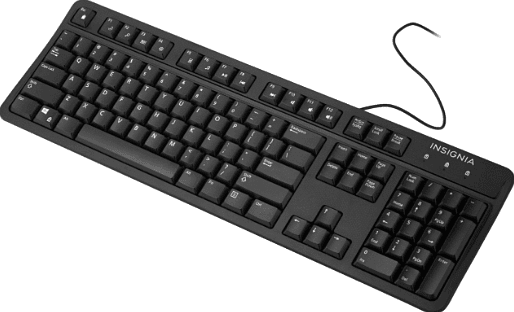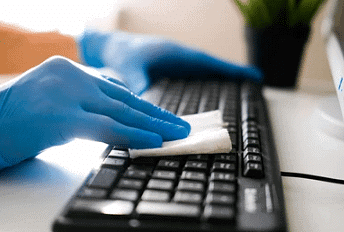Class 1 Exam > Class 1 Notes > International Computer Science Olympiad Class 1 > Olympiad Notes: Keys and Keyboard
Olympiad Notes: Keys and Keyboard | International Computer Science Olympiad Class 1 PDF Download
What is a Keyboard?
The keyboard is like a friend to the computer. It has many keys, and each key does something different. It helps us tell the computer what we want to do.
Example: When you want to play a game or write a story, you use the keyboard to tell the computer what to do.

What are Keys?
- Keys are like tiny buttons on a special board called a keyboard. Each key has a letter, number, or special symbol. It's like having a magic set of buttons that help us talk to the computer.
- Example: When you press the 'A' key, it shows the letter 'A' on the computer screen.
Letters, Numbers, and More:
The keys have letters from A to Z, numbers from 0 to 9, and special keys. Special keys on a keyboard serve various functions and can make using a computer more efficient. Here's a brief overview of the uses of different special keys:
- Shift Key: Makes letters BIG or helps type symbols above numbers.
- Caps Lock: Makes all letters BIG until turned off.
- Tab Key: Helps create spaces or indents in writing.
- Enter/Return Key: Starts a new line or sends information.
- Backspace Key: Erases the letter behind the blinking line.
- Delete Key: Removes the letter in front of the blinking line.
- Arrow Keys (Up, Down, Left, Right): Move around like magic arrows on the screen.
- Ctrl (Control) Key: Helps do special tricks when pressed with other keys.
- Alt Key (Alternate): Does different jobs with other keys.
- Windows/Mac Key: Opens important menus or does special things.
- Function Keys (F1-F12): Each does a different job in programs.
- Spacebar: Makes spaces between words or plays/pauses things.
- Ctrl+Alt+Delete: Opens a special menu on Windows computers.
- Print Screen: Takes a picture of what's on the screen.
- Esc (Escape) Key: Stops or closes things, like magic exit button.
Understanding these keys helps you use the computer easily!
- It's like a special board that can type anything we want!
- Example: If you want to type your name, you press the keys for each letter of your name on the keyboard.
Talking to the Computer:
- The keyboard is how we talk to the computer. When we press a key, it's like telling the computer what we want it to do - whether it's playing a game, writing a story, or searching for fun pictures.
- Example: Pressing the space bar key helps you put spaces between words when you're writing a sentence.
Taking Care of the Keyboard:
- We need to be gentle with the keyboard, just like with our toys. No banging or spilling things on it! We want our magic talking buttons to stay clean and work properly.
- Example: Before using the computer, make sure your hands are clean, so the keys stay nice and shiny.

The keys on the keyboard are like magic buttons that let us talk to the computer. They help us play, learn, and create exciting things. So, let's be friends with our keyboard and explore all the amazing things it can help us do!
The document Olympiad Notes: Keys and Keyboard | International Computer Science Olympiad Class 1 is a part of the Class 1 Course International Computer Science Olympiad Class 1.
All you need of Class 1 at this link: Class 1
|
20 videos|70 docs|40 tests
|
FAQs on Olympiad Notes: Keys and Keyboard - International Computer Science Olympiad Class 1
| 1. What is a keyboard? |  |
Ans. A keyboard is a peripheral device that is used to input data and commands into a computer or other electronic device. It consists of a set of keys arranged in a specific layout, typically resembling that of a typewriter.
| 2. What are keys on a keyboard? |  |
Ans. Keys on a keyboard are individual buttons or switches that are pressed by the user to input characters or commands into a computer. Each key represents a specific character or function and is designed to be pressed with the fingers.
| 3. How does a keyboard work? |  |
Ans. When a key is pressed on a keyboard, it triggers an electrical signal that is sent to the computer. The computer then interprets this signal and associates it with a specific character or function. The input is then processed and displayed on the screen.
| 4. What are the different types of keyboards available? |  |
Ans. There are several types of keyboards available, including:
- Standard keyboards: These are the most common type of keyboards with a full set of keys, including letters, numbers, and various function keys.
- Gaming keyboards: These are specialized keyboards designed for gaming purposes, often featuring customizable keys, backlighting, and additional controls.
- Wireless keyboards: These keyboards connect to the computer wirelessly, typically using Bluetooth or RF technology.
- Virtual keyboards: These are software-based keyboards that are displayed on a touch screen or monitor, eliminating the need for physical keys.
- Ergonomic keyboards: These keyboards are designed with a curved or split layout to provide a more comfortable typing experience and reduce the risk of repetitive strain injuries.
| 5. How can I troubleshoot keyboard issues? |  |
Ans. If you are experiencing issues with your keyboard, here are a few troubleshooting steps you can try:
- Check the connection: Ensure that the keyboard is properly connected to the computer. If it is a wireless keyboard, make sure the batteries are charged or replace them if necessary.
- Restart the computer: Sometimes, a simple restart can resolve temporary issues with the keyboard.
- Update drivers: Check if there are any updates available for the keyboard drivers and install them if needed.
- Test on another device: If possible, connect the keyboard to another computer or device to see if the issue persists. This can help determine if the problem is with the keyboard or the computer.
- Clean the keyboard: Dust and debris can sometimes cause keys to stick or not register properly. Gently clean the keyboard using compressed air or a soft cloth.
If the issue persists, it may be a hardware problem, and it is advisable to seek professional assistance or replace the keyboard if necessary.
Related Searches





















